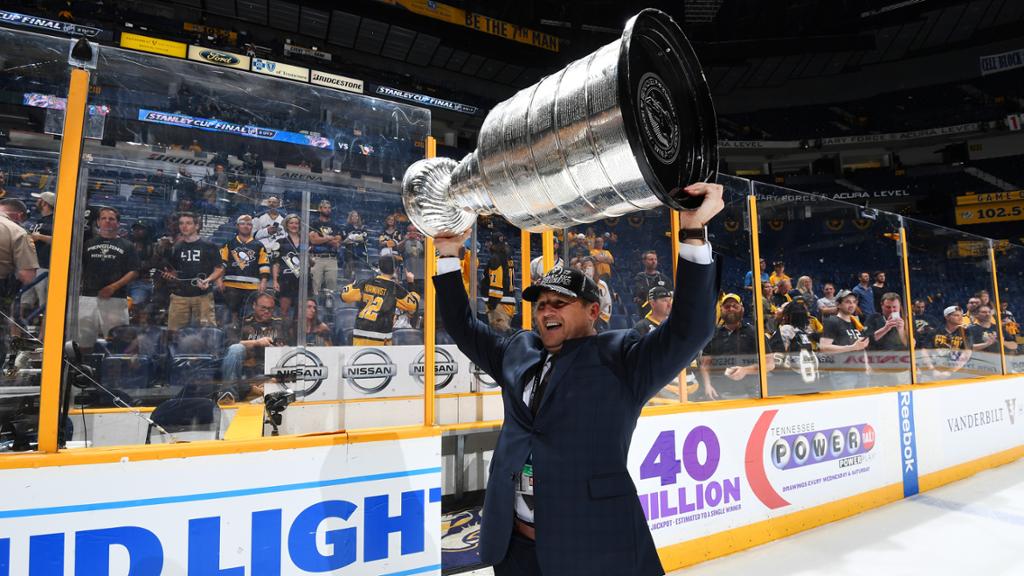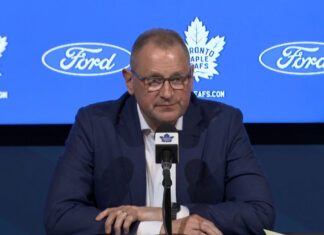After the hiring of Shane Doan earlier in the offseason, Brad Treliving has made his next addition to the Maple Leafs front office with the hiring of a former teammate (with the Columbus Chill of the ECHL) and former Calgary Flames colleague (as a pro scout) as the team’s new Assistant General Manager, Player Personnel.
We are excited to add Derek Clancey to our hockey operations department. I feel Derek is one of the premier talent evaluators in our game. He is a three-time Stanley Cup champion and will play a big role as we continue our goal of building a championship team.
– Brad Treliving
Clancey will presumably slide into the Leafs’ management hierarchy above current Director of Player Personnel, Dave Morrison, assuming the long-time Leafs front-office member — who has been a part of the organization since the John Ferguson Jr. era — remains part of the management team going forward. Morrison works with Assistant Director of Player Personnel, Wes Clark, and oversees the Leafs‘ pro scouts Jackson Maxwell, Matt Moulson, Mike Penny, Richard Pollock, Jim Roque, and Tom Watt.
A member of the Penguins organization from 2007 to 2021 who was originally hired by Ray Shero, Clancey advanced within the organization from the role of pro scout to Director of Pro Scouting during the Penguins’ rise to three Cup wins and one additional Finals appearance. At the time of his departure (following Jim Rutherford’s resignation in 2021), Clancey had been elevated to the role of the Penguins’ Director of Player Personnel for two years.
Clancey later joined Treliving’s Flames in a pro-scouting capacity before rejoining Rutherford in Vancouver as an AGM, a post he departed for this new opportunity in Toronto.
While in Vancouver, Clancey told The Athletic that his pro-scouting staff in Pittsburgh prided itself on its ability to identify lesser-known or under-utilized talent that could fit certain roles/style of play and produce as complementary players around the Penguins’ superstar core talent during their Stanley Cup runs, naming Justin Schultz as an example (we could also add the likes of Nick Bonino and Carl Hagelin, among others, as valuable pro-scouting wins during those back-to-back Cup wins).
Question: With Pittsburgh over the years, there became this run of anonymous guys that turned out to be really good. Guys just seemingly out of nowhere. And there was a joke online about how the Penguins would have guys named “Mark Donk” and “Buzz Flibbet,” and look at that — they both have over 40 points. I’m curious to know, is this something you were aware of as a group or took any pride in?
Clancey: (Laughs) Yeah. When we were in the fire, the thing about pro and amateurs is that when you make a pro decision it’s here tomorrow. You can evaluate a guy pretty quickly, in terms of how he fits with your group. With amateur decisions, you draft a guy and it’s several years down the road before he’s in your group.
So it’s different on the pro side that way — going to what you’re talking about in evaluating players — because if you make a trade for a guy today he’s there tomorrow. He’s playing for you the next night and you find out pretty quickly if he fits, if he has success and where he’s going to go.
I think whenever you make a trade and you feel good about it but you’re not 100 percent happy or sure about it, that’s a good feeling to have. Those are the ones you process, you weigh the pros and the cons in your group. In-house in Pittsburgh we took pride in finding pieces that maybe didn’t fit somewhere else, and that came in and fit with our group. The Justin Schultzs and guys like that.
I remember being in Edmonton listening to Schultz get booed out of the building and you’re reading stuff in the media, but he was a good player, he just didn’t fit for them in Edmonton. Then he comes into Pittsburgh and he was a top-four defenceman for us in back-to-back Stanley Cup runs. I mean, it’s the same player. It’s just about the fit.
We took pride in that as a group. We really put in work on what we wanted in a player. Our American League coaches at the time were John Hynes and Alain Nasreddine and they did an unbelievable job developing players like Teddy Blueger and Conor Sheary and Tom Kühnhackl and Scott Wilson, and getting them ready to play in the NHL. And when they came up to the NHL — and Mike Sullivan had a little bit of experience with some of these players in Wilkes-Barre in his couple of months down there — it all really worked in terms of integrating them into our team, and how we wanted to go with the structure, the speed, the north-south style.
Clancey also told The Athletic that he is “not a big analytics person,” although he’s not completely closed off to it — which is still a noteworthy admission, and may be an example of a departure from the type of brain trust Kyle Dubas would’ve recruited for this kind of role. As the management group stands today, Clancey will be working alongside Darryl Metcalf, whose job is to work with the player personnel department to provide analytics-based insights that can inform their decision-making.
Clancey: Personally, I’m not a big analytics person. I look at a few things, but I don’t use it in its entirety.
I look at a few key factors when I’m looking at a player. I use that, compare it to how I think of a player and see if it correlates. The biggest fear is that I’m here and the analytics are in a totally different place, and you have to ask yourself: Why is it so different? That’s when you try to get to the middle, maybe I’m not seeing something, or maybe the analytics aren’t analyzing something. So you have to dive into it, and see why there’s a big difference.
I think all the information is good. Everyone uses it differently. Some staff members might use it more than I use it. But at the end of the day, it’s just about using all the information available to you. Maybe that’s a generic answer, but that’s the bottom line.

































